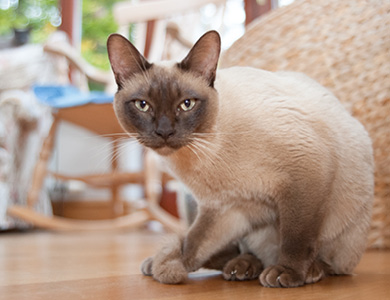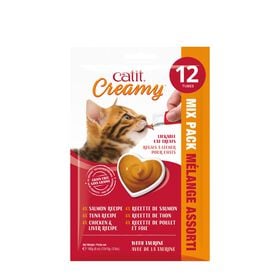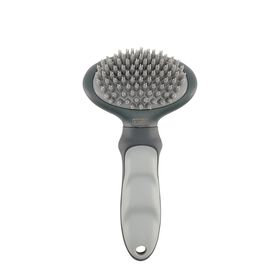Tonkinese were produced by crossbreeding between Siamese and Burmese, and it is believed that they have the best of both breeds. This may be true since Tonkinese have an extremely charming personality and are a perfect blend of the physical characteristics of both breeds.

Morphology and appearance
Tonkinese are a Siamese and Burmese hybrid, resulting in an appearance that is midway between the two founding breeds. However, if a Siamese mated with a Burmese today, the result of their union might not be identical to a Tonkinese. Since the breed criteria have changed considerably, we have to go back to what these two breeds were like in the 1960s. The Tonkinese has a moderate conformation. It is a medium-size cat, with a slender, yet strong and muscular body. The head is shaped like a rounded triangle, slightly longer than wide. The medium-size ears tilt forward and end in rounded tips. The upper eyelid is almond-shaped, while the lower line of the eye is attractively rounded. The tail is neither long nor short, with a rounded tip. Given its well-balanced appearance, the Tonkinese, especially the male, is surprisingly heavy, likely a characteristic inherited from its Burmese ancestor.

The Tonkinese coat is silky, shiny, very thick, short and close-lying. However, what really sets the Tonkinese apart is pattern. The colour—or rather the colour pattern—that originally defined the Tonkinese was referred to as mink. With the genetics of this colour pattern, the cats’ eyes are an extraordinary aquamarine. Today, three colour patterns, all genetically interrelated, are possible:
- Pointed: Almost identical to the Siamese colourpoint, the colour appears only on the extremities of the body, in stark contrast to the rest of the body, which is generally white or cream. The eyes are blue.
- Mink: The colour in the mink pattern is also primarily concentrated on the extremities, namely the ears, muzzle, tips of the paws and tail. However, the rest of the body is also slightly coloured, creating a more moderate contrast with the points. The eyes are aqua.
- Solid (or sepia): Similar to the Burmese colour pattern, there is very little contrast between the points and the rest of the body. The eyes are green to yellow-green, or gold.
Coat colour is independent of pattern, and Tonkinese have many possible coat variations. That said, cat associations sometimes impose certain restrictions. TICA (The International Cat Association) has accepted all 14 colours, including the tortie colours, each of which can be found in the pointed, mink and solid patterns. When the tabby pattern is added, the possibilities are almost endless. The CFA (Cat Fancier’s Association), however, recognizes only four base colours in the three patterns: naturel (medium brown), champagne (buff-beige), blue and platinum. In Canada, the Canadian Cat Association recognizes six colours: naturel, champagne, honey, blue, platinum and fawn.

Behaviour
Life with a Tonkinese is never boring. These active cats like to play alone, with humans and, if cohabitation is favourable, even with other cats and the family dog. However, they can get into mischief if their needs aren’t met. Curious and social, they’re very interested in family life. They may even enjoy making conversation. Some Tonkinese express themselves using a range of sounds reminiscent of words, or even sentences. These fun-loving cats are also very affectionate and like to cuddle with their favourite humans.
Level of maintenance (grooming)
In general, Tonkinese require only a weekly brushing with a soft rubber brush. As is the case with all cats, regular tooth brushing is strongly recommended to prevent oral disease. Their claws should also be trimmed, as needed.

Origins
Modern-day Tonkinese are the result of crossbreeding between Siamese and Burmese. In the 1960s, without knowing what the other was doing, two breeders worked on developing this new breed. The first, Jane Barletta, a U.S. breeder, wanted to cross Siamese with Burmese to produce a breed with more moderate characteristics that was distinct from the two original breeds. In Canada, Margaret Conroy crossed a female Burmese and a Siamese. Some of the resultant kittens had such a fascinating coat colour and, in particular, aqua eyes that she decided to work on the genetics behind this colour. The two women eventually worked together to develop the breed and promote it among various cat associations, but it was really more of a RE-birth.
In reality, the Tonkinese existed well before being recognized, probably always a hybrid of a Siamese and a dark-coloured cat, similar to the Burmese. This is described in the Tamra Maew, a collection of domestic cat poems written by Buddhist monks in ancient Siam that dates back to somewhere between 1358 and 1767. Closer to home, in 1930, another Tonkinese held an important place in the history of domestic cat breeds. At the time, however, Tonkinese were not known or recognized. Named Wong Mau, the small cat was seen as a Siamese with unusual characteristics, including a much darker coat colour. Dr. Thompson decided to bring the cat to the U.S. from Burma, the cat’s country of origin. By crossing Wong Mau with a Siamese and by studying the genetics of colours when breeding the offspring together, he isolated the sepia pattern of the Burmese, as it is known today. It is now known that Wong Mau was a Tonkinese. Fascinating that a Tonkinese produced a Burmese, which made it possible to redevelop the official Tonkinese 30 years later!
Unusual facts
There is a medium-haired variety of Tonkinese sometimes referred to as Tibetan, which is not yet fully recognized. It is the result of crossing a Burmese with a Balinese, a Siamese with medium-length hair. As is the case with the Siamese, the Tonkinese coat colour darkens with age.









